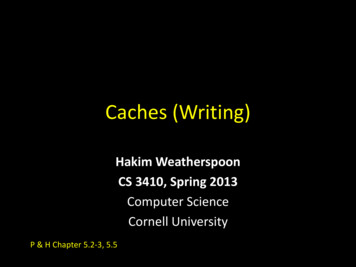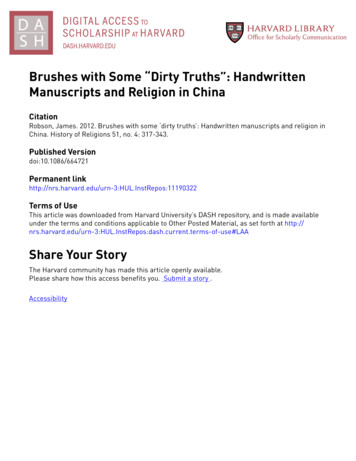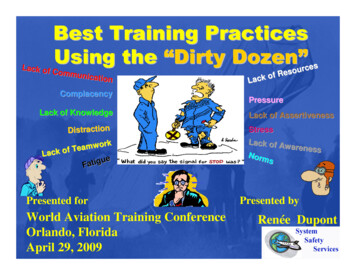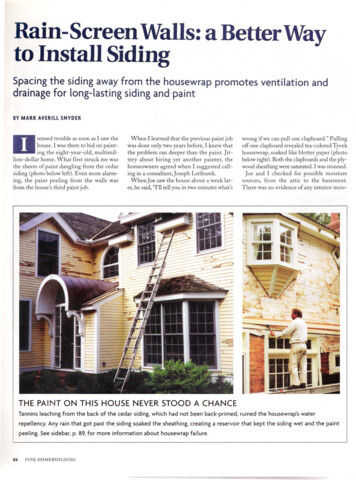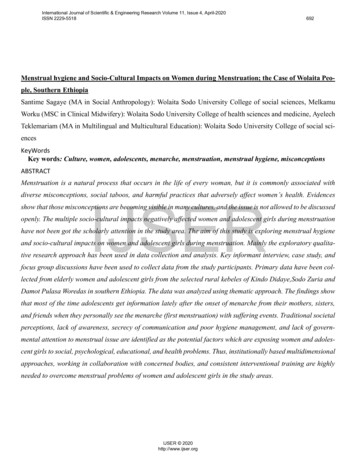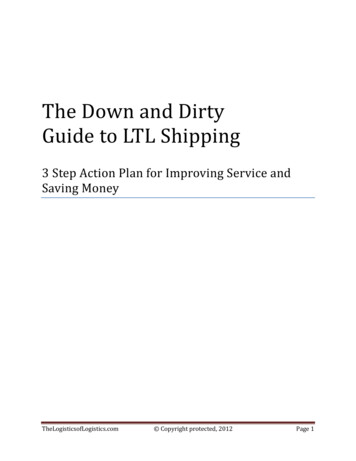
Transcription
The Down and DirtyGuide to LTL Shipping3 Step Action Plan for Improving Service andSaving MoneyTheLogisticsofLogistics.com Copyright protected, 2012Page 1
Introduction: The Down & Dirty Guide to LTL ShippingThis guide was written for Less-Than-Truckload (LTL) shippers who want todramatically improve their on time performance, and billing accuracy while reducing costand damaged shipments.For those of you interested in complexity, jargon or theoretical approaches, you came tothe wrong place.The methods written about here are simple, proven and can be implemented with aminimum amount of time and little or no investment.The essentials of LTL transformation can be summarized in three simple steps.1. Measure the four key LTL freight metrics: cost, on-time performance,freight damage and billing accuracy2. Analyze the four key freight metrics every week, ideally with yourteam3. Identify and implement actions that will improve the freight metricsThe next 3 sections of this guide will fill in the details behind each step.TheLogisticsofLogistics.com Copyright protected, 2012Page 2
Section 1: Measure the Four Key LTL Freight MetricsIn LTL shipping, the four most important attributes are: cost, on time performance,billing accuracy and damage free shipments.CostThe ultimate metric for measuring cost performance is cost per pound. The metric iseasy to create, completely transparent, and will give you great insights into your freightspending.To create the cost per pound metric, take the cost of the shipment and divide it by theshipment weight (pounds). Example: 507.34 divided by 1440 lbs. equals 0.35 costper pound.Cost per pound for LTL shipments will vary depending on the freight class, carriers, andpick-up and delivery points. Cost per pound will vary between 0.10 and 0.75 withmost shippers falling in the 0.22 - 0.42 range. Lower cost per pound is obviouslybetter because it means the shipments were less expensive.The cost per pound metric can be used to compare individual shipments, carriers, andeven weekly invoices.On Time PerformanceAll LTL carriers provide an estimated transit time for shipments, however those transittimes are not guaranteed. Most carriers will have on time performance of 90% or better,but understanding exactly how a carrier performs on your lanes will help your companymake better choices.The metric is easy; simply divide the number of on time shipments by the total numberof shipments. Example: 40 on time shipments divided by 43 total shipments equals93% on-time performance.Billing AccuracyIncorrect freight bills drive the accountants crazy! In addition to the hours of reconcilingbad bills, the added cost has to be accounted for somehow. Sometimes it has to bepassed on to clients, who were already billed for freight or the added cost has to beabsorbed by the company.Some companies pay outside auditors to identify and recover billing errors. Auditorsusually get paid for each bill audited and some even get a percentage of the recoveredsavings, so they have a vested interest in more incorrect bills.TheLogisticsofLogistics.com Copyright protected, 2012Page 3
A freight bill should match the quoted price, unless the shipper provided an incorrectweight, freight class or NMFC number. Most shippers can begin saving moneyimmediately by doing those three things correctly. The carrier and or the logisticscompanies involved can help the shipping group identify the correct NMFC and freightclass.To calculate the billing accuracy, divide the number of correct bills by the total numberof bills. Example: 61 correct bills divided by 64 total bills equals 95% billing accuracy.Damage Free ShipmentsCost, on time performance and billing accuracy don’t mean much if the carrier damagesthe freight. Freight damage must be measured.Be sure to measure all damage not just freight claims filed. Damaged packaging, smallscratches, and loose pieces are all upsetting to the receiver and the end customer sothey should be documented and measured, even if there isn’t a freight claim filed.Freight damage should always be far less than 1% of total shipments. If freight damageis over 1%, there is something seriously wrong with the packaging, loading / unloadingprocess or the carrier.To calculate the number of damage free shipments, divide the number of damage freeshipments by the total number of shipments. Example: 112 damage free shipmentsdivided by 113 total shipments equals 99.1% damage free shipments.The LTL Scorecard: Pulling it All TogetherNow that the metrics have been created, the next step is to measure each carrier on thefour metrics: cost, on-time performance, billing accuracy and damage free shipments.The best way to review and analyze the data is to consolidate it all on an LTL Scorecard(see Figure 1).It is very important to compare the metrics to past performance and identify trends, bothgood and bad. In addition to measuring the weekly shipments, shippers should alsotrack the year to date metrics for the purpose of comparison.TheLogisticsofLogistics.com Copyright protected, 2012Page 4
Figure 1 – LTL ScorecardOngoing comparison betweenweekly and year to date metricsTheLogisticsofLogistics.com Copyright protected, 2012Page 5
Section 2: Analyze the Four Key Freight MetricsThe LTL Scorecard and associated metrics should be updated and distributed to teammembers every week.The team should meet to review and analyze the LTL Scorecard. Hopefully, there isalready a team in place to review the scorecard, but if not a team should be formed withrepresentatives from logistics, operations and accounting.The power of the scorecard is that the areas of opportunity are very noticeable andpractically jump off the page at the users.In the example above, the following observations and or opportunities for improvementwould be highlighted and discussed.Total Shipments: There were 77 total shipments with the majority moved byUPS and Pitt Ohio. Is that more or fewer shipments than usual? Based on themetrics, should other carriers receive more shipments?On-Time Performance: The total on-time performance for all carriers was96.1% which is better than the YTD metric of 95.7. What caused theimprovement? What caused the late shipments by UPS, Pitt Ohio and OldDominion? What changes should be made to improve the on-time percentage?Billing Accuracy: The total billing accuracy percentage for all carriers was97.4%, which is better than the YTD metric of 94.3%. What factors affected thepercentage? What caused the billing problem with R&L and Watkins? Howmuch extra did it cost the company? What changes should be made to eliminatethe billing errors?Damage Free Shipments: There were no damaged shipments reported thisweek. Congrats to the team! What actions helped prevent freight damage?Cost Per Pound: The overall cost per pound was 0.196. Which carriers wereabove and which were below 0.196? Were the higher cost shipments causedby shipping locations? Were the higher cost shipments caused by freight classdifferences? Would adjustments to the carrier mix lower the overall cost perpound?As you can see from the example above, the LTL Scorecard metrics highlight lots ofopportunities and areas for further analysis.Updating the LTL Scorecard is important, but the real benefit, is the actions taken toimprove the metrics.TheLogisticsofLogistics.com Copyright protected, 2012Page 6
Section 3: Identify and Implement Actions That WillImprove the Freight MetricsIn this section, there is a description of seven actions that will improve the freightmetrics, which will improve the shipping function and ultimately boost the bottom line.Each of the actions impacts at least one of the metrics. The actions are: 1.) ImprovePackaging, 2.) Make carrier changes, 3.) Use longer transit times, 4.) Reduce freightclassifications, 5.) Select the right shipping mode, 6.) Use transportation managementsoftware, 7.) Hire a 3rd party logistics company1. Improve PackagingProper packaging will minimize freight damage and fit the goods into the minimumspace necessary. Using less space on the truck will reduce the freight classification,which in turn will reduce shipping costs. Improved packaging can also reduce freightdamage. Additionally, good packaging is easy to load, unload and has good labelvisibility. Questions to consider: When was the last time, you looked at yourpackaging? Is damaged freight an ongoing problem? Do your shipments have a highfreight class?2. Reduce Freight ClassificationFreight class is set by the National Motor Freight Transportation Association, andgenerally determined by freight density (the denser, the better). Improved packaging(see above) will sometimes lower your freight class which will lower your freight costs.Another way to lower your cost is to investigate whether your freight could ship under alower classification. There are lots of nuances to the freight classifications so do someresearch and or ask your carrier representative for help. Questions to consider:Does your shipping team understand the correct freight classes for your freight? Doesyour company ever have freight reclassified by the carrier? Does your shipping teamunderstand the connection between freight density and freight class?3. Select the Right Shipping ModeFreight mode refers to the various shipping methods, which include: full truck, LTL,small parcel, air freight, and sea freight. Shippers often focus on getting the best pricefor a given mode without considering the opportunity to use a less expensive mode.Using the wrong mode will cost your company extra money. For some larger LTLshipments, a dedicated full truck might be a cheaper than LTL. Conversely, somesmaller LTL shipments might be shipped cheaper by a small parcel carrier. Questionsto consider: Do you have light LTL shipments that could ship via small parcel? Doesyour company use full trucks for 6 pallets or less? Has there ever been an analysis ofthe proper shipping modes at your company?TheLogisticsofLogistics.com Copyright protected, 2012Page 7
4. Make Carrier ChangesCarrier changes can have an enormous impact on all the four of the freight metrics.Every carrier has preferred routes where they will offer better pricing. Conversely, everycarrier has areas where they do not want to go and of course they charge more forthose moves. Selecting the preferred routes for carriers will also improve on timeperformance. If freight damage is an ongoing concern, switching carriers sometimesfixes the problem. A good carrier representative will work with clients to improve billingaccuracy through clear language in the tariff contract. Questions to consider: Do youknow the carriers with the best coverage for the areas where you ship? Do yourcarriers use partner carriers to deliver your shipments? If yes, those shipments costextra money and are more likely to be damaged. Does your company regularly meetwith carrier representatives to better understand their service offerings?5. Switch to Longer Transit TimesShippers often default to the fastest transit time without considering the extra costs. Ingeneral, shorter transit times are more expensive than longer transit times. Questionsto consider: Are you paying a premium for a one day transit time for a shipment that isnot time sensitive? Would you ship earlier and use a carrier with a longer transit time, ifit meant a significant cost savings? Would your customer accept a later delivery time ifyou gave them a break on shipping costs?6. Use Transportation Management SoftwareTransportation management software (TMS) can help shippers reduce cost, improvebilling accuracy and on time performance. TMS simplifies the freight buying process forshippers. Typically, TMS will enable a shipper to compare pricing and transit times formultiple carriers. After selecting a carrier, TMS will facilitate easy tracking, reportingand payment. The best transportation management systems are web based andconnect shippers directly to the LTL carriers. Having a database of all LTL shipmentsaids in metric development and reporting. A good TMS can be expensive, but some3PL’s offer the software for free with their services. Questions to consider: Do youhave freight software to streamline the freight buying process? Are freight bills easilyaccessible online? Is shipment tracking and visibility a problem at your company? Howlong does it take to get quotes from 3 carriers? If it is longer than one minute, a TMSmight be useful.7. Hire a Third Party Logistics Provider (3PL)A good third party logistics provider will improve cost, on-time performance, freightdamage, billing accuracy and a whole lot more. The best 3PL’s provide free web basedsoftware along with logistics experts that will drive continuous improvement. Dependingon the shipper’s needs some 3PL’s take over routine freight tasks, which frees up theshipper’s logistics team. Since 3PL’s partner with dozens of LTL carriers, they canmatch a shipper with the best carriers for their situation. Questions to consider: IsTheLogisticsofLogistics.com Copyright protected, 2012Page 8
your shipping team experienced in carrier negotiations? Does your company have thetime or the carrier relationships necessary to get the best pricing? Would some freightexperts and TMS help the freight area run more effectively?TheLogisticsofLogistics.com Copyright protected, 2012Page 9
Conclusion: The Down & Dirty Guide to LTL ShippingThe key to improving LTL freight shipping is a culture of continuous improvement. Thefirst step in continuous improvement is objective metrics of the current state. Oncethere are objective metrics, the actions necessary for improvement become much moreobvious.Additionally, having good metrics enables the freight team members to make goodinformed decisions, which will ultimately benefit the company’s bottom line.TheLogisticsofLogistics.com Copyright protected, 2012Page 10
About The AuthorJoe Lynch wrote the “The Down and Dirty Guide to LTL Shipping”. Joe is the GeneralManager and COO of Rock Solid Business Solutions. He is also the founder and chiefblogger at TheLogisticsofLogistics.com.The scorecard and processes described in the guide have been used by Joe and histeam to save millions of dollars for clients over the past three years. When you have agreat team, good metrics and a culture of continuous improvement, anything is possible.Mr. Lynch has over 25 years of experience with automotive OEM’s and tier 1 suppliers.He has held a variety of roles in: program management, product development,engineering, manufacturing, logistics and supply chain.Prior to joining Rock Solid, Joe spent 3 years as the head of consulting at AppliedTechnologies, Inc. (ATI) where he led a number of initiatives within Chrysler. Projectsincluded: lean strategy and implementation (value stream mapping), automotive moduleoutsourcing strategy, best practice development and knowledge management(software). Earlier in his career he launched new vehicle programs in China andThailand.Mr. Lynch earned a bachelor’s degree in Business Administration from Cleary Universityand a Master’s degree in Education from the University of Michigan. His master’sdegree concentration was Adult Instruction and Performance Technology.TheLogisticsofLogistics.com Copyright protected, 2012Page 11
uide to LTL Shipping This guide was written for Less-Than-Truckload (LTL) shippers who want to dramatically improve their on time performance, and billing accuracy while reducing cost and damaged shipments. For those of you interested in complexity, jargon or theoretical approaches, you came to the wrong place.


